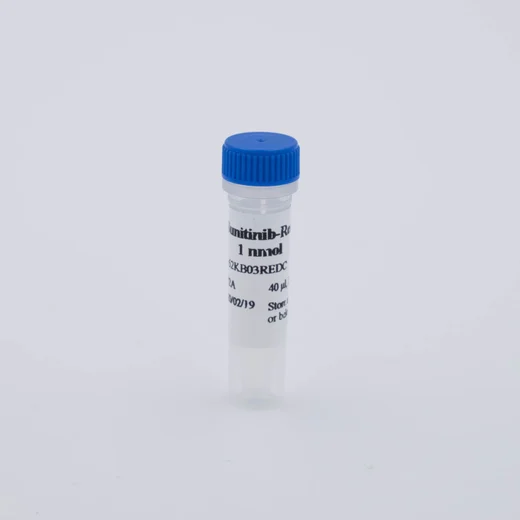

HTRF Sunitinib Red Ligand, 1 nmole


HTRF Sunitinib Red Ligand, 1 nmole






Sunitinib-Red is a derivative of Sunitinib, and has been validated as a fluorescent tracer for HTRF Kinase Binding assays.
For research use only. Not for use in diagnostic procedures. All products to be used in accordance with applicable laws and regulations including without limitation, consumption and disposal requirements under European REACH regulations (EC 1907/2006).
| Feature | Specification |
|---|---|
| Application | Biochemical Enzymatic Assay |
Sunitinib-Red is a derivative of Sunitinib, and has been validated as a fluorescent tracer for HTRF Kinase Binding assays.
For research use only. Not for use in diagnostic procedures. All products to be used in accordance with applicable laws and regulations including without limitation, consumption and disposal requirements under European REACH regulations (EC 1907/2006).



HTRF Sunitinib Red Ligand, 1 nmole



HTRF Sunitinib Red Ligand, 1 nmole



Product information
Overview
This compound is derived from Sunitinib, which is a well known inhibitor of the PDGF and VEGF RTK families. Sunitinib, which is an ATP-competitive Kinase inhibitor, is used as a drug to treat renal cell carcinoma and imatinib-resistant gastrointestinal stromal tumors. It has been shown to bind with an affinity of <100 nM to about 18% of the Kinases (both RTK and Ser/Thr). It is therefore useful to address multiple Kinases in the HTRF Kinase Binding assay platform.. The ‘d2’ fluorescent dye used absorbs with its maximum near 650 nm and fluoresces near 670 nm. It is used as an acceptor molecule in HTRF assays.
Sunitinib-Red is supplied as a 25 µM solution in DMSO.
Specifications
| Application |
Biochemical Enzymatic Assay
|
|---|---|
| Brand |
HTRF
|
| Detection Modality |
HTRF
|
| Product Group |
Fluorescent Reagent
|
| Shipping Conditions |
Shipped in Dry Ice
|
| Target Class |
Kinases
|
| Technology |
TR-FRET
|
| Therapeutic Area |
Metabolism/Diabetes
Neuroscience
Oncology & Inflammation
|
| Unit Size |
1 nmol
|
Video gallery

HTRF Sunitinib Red Ligand, 1 nmole

HTRF Sunitinib Red Ligand, 1 nmole

How it works
Kd determination assay principal
The binding of Sunitinib-Red is detected in a sandwich assay format using the Anti Tag labeled with Europium Cryptate (donor), which binds to the tagged Kinase, and a red fluorescent tracer labelled with d2 (acceptor).
The detection principle is based on HTRF® technology. The HTRF ratio (665/620) will increase upon the addition of more of the tracer, and will saturate depending on the dissociation constant (Kd) of the tracer to the tagged kinase.
To know whether Sunitinib-Red is the tracer best suited to your tagged kinase of interest, we advise you to try the Kinase Binding Discovery kits.

Kd determination assay protocol
Saturation binding experiments of Sunitinib-Red can be run in 96- or 384-well plates (20 µL final volume).
First, a dilution series ranging between 0 and 1 µM of Sunitinib-Red in the Kinase Binding Buffer is prepared in a 96-well non-binding plate. Next, 5 µL of Kinase Binding Buffer are dispensed into the final 96- or 384-well plate. Then 5 µL of tagged-Kinase are added, followed by 5 µL of Anti-tag Eu-cryptate. Finally, 5 µL of the red tracer solution are added.
The HTRF ratio is measured after 1H of incubation.
IC50/Ki determination assay principle
The binding of Sunitinib-Red is detected in a sandwich assay format using a specific Anti-GST, 6HIS antibody or Streptavidin labeled with Europium Cryptate (donor), which binds to the tagged Kinase, and a red fluorescent Sunitinib labelled with d2 (acceptor).
The detection principle is based on HTRF® technology. The HTRF ratio (665/620) will increase upon the addition of more Sunitinib-Red, and will saturate depending on the dissociation constant (Kd ) of Sunitinib-Red to the tagged kinase.
When an inhibitor of the kinase is added, Sunitinib-Red will be displaced and the HTRF signal will disappear, depending on the dose.

IC50/Ki determination assay protocol
Pharmacological evaluation of inhibitors of interest can be run in 96- or 384-well plates.
First, a dilution series of inhibitor ranging between 40 µM and 0.23 nM is prepared, and 5 µL of each concentration are dispensed into the plate. Next, 5 µL of tagged-Kinase are added, followed by 5 µL of anti-tag Eu-cryptate. Finally, 5 µL of Sunitinib-Red solution are added, prepared at 4x the final concentration. The HTRF ratio is measured after 1 H of incubation.
Analyses of the data give typical dose response curves ranging between 10 µM and 56 pM, enabling an evaluation of the IC50/Ki values for the inhibitor of interest.

Assay validation
Saturation Binding (Kd)
Before perfoming competitive binding studies of inhibitors, the dissociation constant (Kd) of Sunitinib-Red has to be determined on the tagged Kinase of interest. This can be done with the help of the Kinase-GST/6HIS/biotin Discovery kits. A typical saturation binding experiment is performed using tracer concentrations between 0 and 250 nM, and measuring total- and non-specific binding signals. Subtracting the non-specific from the total binding signal gives the specific signal, which can be analysed to give the Kd. Here an example is shown for the determination of the Kd (56 nM) of Sunitinib-Red on 5 nM PDGFRb-GST.

Competitive Binding (IC50/Ki)
Dose response curves of various known kinase inhibitors (Staurosporine, Dasatinib, Imatinib, Tozasertib, Sunitinib, and Gefitinib) were measured using Sunitinib-Red at its Kd (56 nM) on 5 nM PDGFRb-GST. Staurosporine, Dasatinib, Sunitinib, and Imatinib show show high potencies in good correlation with literature values.

Resources
Are you looking for resources, click on the resource type to explore further.
Discover the versatility and precision of Homogeneous Time-Resolved Fluorescence (HTRF) technology. Our HTRF portfolio offers a...
This guide provides you an overview of HTRF applications in several therapeutic areas.


How can we help you?
We are here to answer your questions.






























